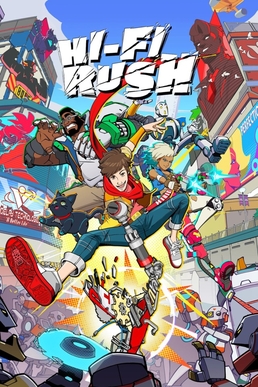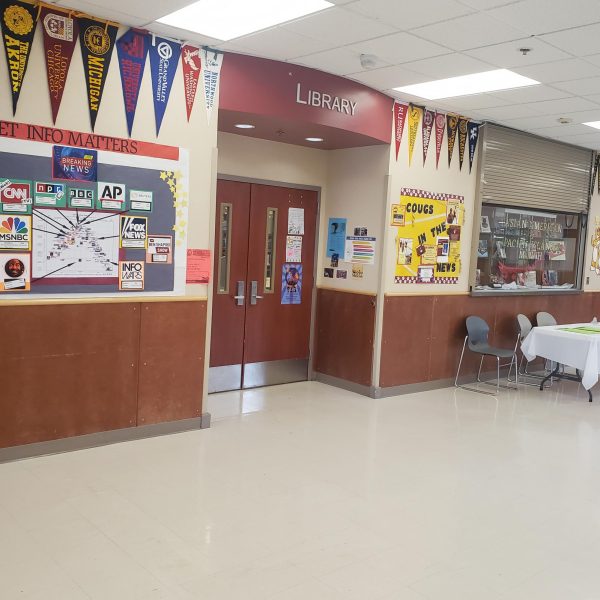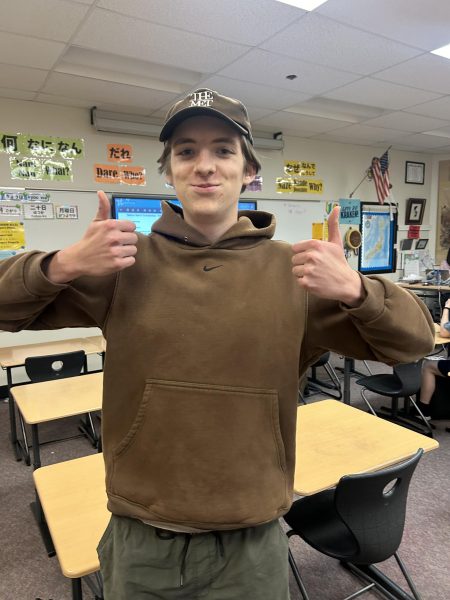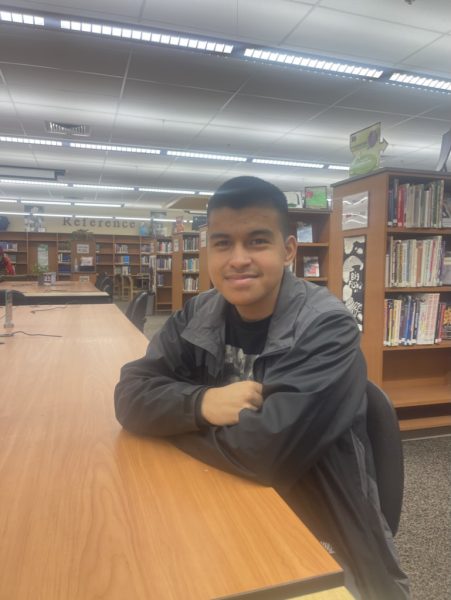The Evolution of LGBT Representation in Video Games
February 2, 2023
If you were to guess when and where gay marriage was first seen in video games you’d probably say 2011, 2008 even, probably in some obscure visual novel type game. Not even close. September 30th, 1998, a top-down RPG was released to the public by Black Isle studios, published by Interplay Entertainment to PC, by the name of Fallout 2. If you’re a fan of the Fallout games, this is likely not that big of a surprise to you, but as an outsider, hearing that one of the most popular video game franchises in the world included gay marriage 3 years before any country had even legalized it could come as a shock. Unfortunately, due to a lot of generalizations and deep seeded ideas, video games have very low expectations set on them for LGBT representation, an idea even seen by gamers in modern times.
I am by no means the biggest gamer out there, I wouldn’t even consider myself really that good at video games, but despite all that, I am very passionate about the games I play. Popular and obscure, AAA and indie, shooters and dungeon crawlers, I spend a lot of time playing games. The beauty of the medium is astounding to me as an artist, time and time again I have seen games used to tell truly beautiful stories, absolutely setting it apart from any other medium in my eyes, they truly are something special. I myself am a gay man as well, so I understand as much as any LGBT gamer the importance of games representing us. That said, I am honestly a fan of how gaming is in modern times with representation. I like playing games and being pleasantly surprised when a character mentions she’s on estrogen, or when a character casually brings up his ex-boyfriend or something. I want to stress here that this is in no way an article to complain about the past or present of gaming, I am not proving a point, this is a general discussion on this topic as I find it quite fascinating.
The first LGBT characters I had personally seen in a video game (as well as anything at the time) was Undertale’s Alphys and Undyne. Now, back when I was 10, I didn’t understand the importance of this, neither gay nor man were really on the table for me while that young, but I remember being shocked, not even considering the possibility of queer characters before then, and still not completely getting this whole gender and sexuality thing, kinda just seeing a girl fish and a girl dinosaur in love without any real word for what that was.
That being said, Undertale was far from the first time a gay character was seen in video games. That title would be given to 1985’s French visual text based murder mystery game Le Crime du Parking (eng: The Car Park Crime) for Apple II. The character in question is the eventual culprit, who is, according to Wikipedia “…the tailor, Paco, who is gay and deals drugs.” I’m sure I don’t have to explain the issue here. Despite the disappointing and slow start, 1985 marked an important date in video game history and the representation of LGBT people that would continue on to this day. Poorly done LGBT characters would continue being a part of a handful of games throughout the latter half of the 80s, save for the very rare indie game distributed on various bulletins. The following decade would show immense growth in the video game industry, though starting off with the expected villain and joke characters, video games would gradually start taking the sexuality of their characters less and less like a joke, and though the 2000s wouldn’t have significantly more LGBT characters, more and more developers, indie and AAA alike, would be more and more willing to allow characters of varying sexuality and gender identity into eyes with more eyes on them.
In modern times, representation in our games can be as good, if not better than what we see on our TVs or in our movie theaters. Despite still not even halfway through the decade yet, the 2020s have already seen nearly as many games with LGBT representation as the entirety of the 2000s alone. When it comes to representation like this, one always has to ask which was the first big example to trek into the public eye and start the process of normalization. Fiction podcasts had Welcome to Nightvale, TV had Will and Grace, and comic books had every instance of the Joker ever. This is all to say, LGBT representation in specific mediums isn’t linear, there is no ‘y+acceptance= #of gay characters’ you can chart on a graph. Realistically, someone has to make something very popular in order to open the proverbial floodgates, showing both consumers and fellow, more popular creators alike that LGBT characters can ‘work’ in the medium. When it comes to early video game LGBT representation, it’s not really clear exactly who this theoretical game is so easily without having been paying attention to this type of thing while it was unfolding, despite this, I think I know the game, or rather games we can pin this role to.
[IMAGE OF THE 5 LGBT CHARACTERS IN FALLOUT 3]
Let’s circle back to where we started this article, but rather than pick back up on the classic Fallout games, I want to take a look at the start of what many fans consider ‘Modern Fallout’. 2008’s Fallout 3 was a game changer for the franchise in pretty much every way, being the first game in the franchise to drop the top down RPG genre all together, as well as being the first made by Bethesda Softworks, the owners of the series from here on out. Aside from the obvious, another potentially risky decision in the game was the inclusion of 5 LGBT characters that can be found all across the wastelands of DC, a WLW (lesbian) couple (both having unspecified sexualities), a MLM (gay) couple between a bisexual and gay man, and a standalone gay man, all 5 being merchants in game. These characters are actually quite interesting looks into LGBT representation at that time in the US, especially considering how LGBT folks were still perceived negatively by a good portion of audiences. Carol and Greta are the lesbian ghoul owners of the Underworld’s restaurant and hotel, but what keeps them both in discussions to this day is their implied status as gay adopted parents, something that had barely been seen in any media at this point, much less a game of this size. Now, full transparency here, much of the discussion on this in-game is strictly implied, never stated, so a completely fair argument could be made that it doesn’t count, in my opinion representation only really counts if seen in text so I absolutely understand. Moving on, let’s take a look at Flak and Shrapnel, a pair of weapon merchants that can be found in Rivet City. At the time of Fallout 3’s release stereotypes of LGBT (especially gay) men were very much a part of how we were perceived on a whole, when it comes to these two, it’s obvious there was a purposeful attempt to avoid such stereotypes, being two typically masculine men who sell guns for a living, a very fascinating type of LGBT representation not commonly seen this far back, but seen commonly enough in modern times. Lastly there’s Anthony, a character going directly against everything that was intended with Flak and Shrapnel, being your typical stereotypical gay man who flirts with every man he interacts with. This character is definitely not the best, and is very strange when sat next to the others, probably a result of having multiple writers due to the sheer size of this game.
Now, if you’re a Fallout fan, you’re probably thinking I’m crazy for talking about Fallout 3 before talking about this next game in the series when talking about LGBT representation, and you’re going to double down on that after how little I have the time to discuss is going to be. I apologize for my insistence on chronological order, and trust me, there is a lot of restraint to not talk about every aspect of the game. Maybe in a future article.
[PICTURE OF ARCADE AND VICTORIA]
Fallout: New Vegas is a pseudo spin-off of the Fallout series created in 2010 by outsourced developers Obsidian Entertainment, a developer founded following Fallout 1 and 2s’ original dev team being dissolved, being created in its ashes. While the game uses an identical engine and style to its predecessor, Fallout: New Vegas is considered very highly as the crown jewel of the series by most who play it. This information is important to know in understanding this game’s effect on the culture of video games in relation to LGBT representation. You see, many fans, including myself, believe Fallout: New Vegas, a 2010 game, to be one of the best examples of LGBT representation, not only in the Fallout series, not only in video games, and not even for time, but just in general. New Vegas, despite what expectations would have you believe, is a game able to break tropes and issues with LGBT characters we see to this day. Between the various skill perks allowing you to flirt with the same gender, themes of homophobia in an environment not exclusively focused on that, and extensive amount of side characters stated in text to be LGBT, I think the part that solidifies all this is the two openly homosexual companion characters. If you aren’t too familiar with the series, this probably isn’t any bigger than some random shop owner to you, but companions in the Fallout series are a staple, almost able to completely change the perception of everything you come across, each character made to be tolerable for hours of gameplay at a time. New Vegas’s Arcade Gannon and Victoria Santangelo are the two characters in question, both strong characters, able to be unique and interesting on their own. This was a breath of fresh air for many, being used to their media having bland or stereotypical characters as representation for their sexualities. Even playing the game back in 2020, 10 years after its release, I remember being in awe that such essential characters with personalities and lives so separated from them being gay, openly talking about their attraction to the same gender in passing like a real openly gay person would, all that while still maintaining the flaws of any other character. If you’re straight, it’s likely that it seems pretty basic, unfortunately, it’s hard to really explain myself here, just know that these two are considered highly as far as representation goes for us even 12 years later. I digress, it’s no doubt that Arcade and Victoria had huge effects on video games, strong well made gay characters in a popular game series typically seen as masculine even in modern times was just the push that the 2010s needed, role models for the entire medium moving forward.
[PICTURES OF ALL/ MOST LISTED GAMES, ONE OF THE INDIE GAMES ONE OF THE AAA GAMES]
After Fallout 3 cleared the path and Fallout: New Vegas laid the tracks, the following decade was predictably the strongest decade ever when it came to LGBT characters. As the number of popular indie games spiked alongside these numbers, many games without the fear of publisher restrictions were able to add LGBT representation to far more games that would be seen by the public eye. Undertale, VA-11 HALL-A, Night in the Woods, Deltarune, Disco Elysium, all indie games given the spotlight, all with lead LGBT characters made by indie teams or even just a few people. Even big developers would join in on this in significant ways. Dragon Age Inquisition, Rainbow Six Siege, Life is Strange, Destiny 2, Borderlands, I mean, have you played Watch_Dogs 2? It might be one of the most gay games I’ve ever played and somehow Wrench is the only LGBT main character, but that’s probably just San Francisco. Looking at these titles and others from this decade, even at a glance, one interesting aspect of LGBT characters in gaming becomes clear. Typically in TV and movies, rates of gay representation are very much based on demographic and genre, an action movie will always be less likely to have representation for us as compared to a comedy or drama, all this boils down to the perceived idea of the audience’s ideals. In the minds of many big companies, more typically masculine pieces of media will receive more backlash for having important, unapologetic, stated LGBT characters than any other genre, but when you even glance at the titles with significant amounts of representation, this seems to completely go out the window in video games. Let me elaborate. I’ve already spoken about the Fallout franchise in this vein, many would definitely consider that masculine due to its status as an FPS, but the sheer amount of masculine perceived genres where so many of the most popular games have significant numbers of LGBT main characters was not something I expected going in. Fighting games, online FPS games, tactical games, games from these genres shown to be very expectedly masculine in presentation and concept, but still including characters of all sorts of gender identity and sexuality, sometimes with gay representation to the extent of a game like Hades, a game where representation’s inclusion was literally not an option due to original source material. Even with gender identity, a topic I lacked too much experience with in the games I usually play, there is characters in these typically masculine genres that that go by they/them pronouns, are stated to be genderqueer, are stated to be transmasc or transfem, all something that, again, even I didn’t expect from games like this going in.
Despite the fact I only really talked about half of what I wanted to, I think I’ve made myself pretty clear. As someone who picked up what a gay person even is through video games, I think I’m a clear example of one of the many reasons games with good representation are so important, I would have spent a lot more time confused about myself if it weren’t for video games. The juxtaposition of the outside perception of video games as compared to their actual content has always been a big issue with the medium. The fallout of 1993 US video game senate hearing still has lasting repercussions today on how many who don’t play video games see them, overly masculine, violent, and corrupting. In their eyes every game is just Doom and somehow that causes people to be unempathetic towards human life and more angry, unlike violent TV shows that they pay no mind to. All this said, with this perception in mind, it’s no wonder some are so surprised on how well LGBT people have been represented in video games, people have a tendency to generalize gamers as homophobic, sexist men who would never play something with a gay person in it. I think the general idea of a gamer should be more like a board game player, someone that watches shows, which is to say nothing. Video games are a medium just as capable as any other to have nuanced stories and by extension characters. If a game can have better representation for gay characters 10 years ago then any show I can think of that’s released in the last 3, I think that alone proves my point.





